Steven Scott Gallery specializes in
contemporary paintings and works on paper by emerging, mid-career and
established American artists.
Born and raised in Baltimore, Maryland,
Steven Scott founded the Steven Scott Gallery in the spring of 1988. He represents
twenty emerging, mid career and established contemporary American artists. Scott
has curated over two hundred gallery exhibitions of their paintings and works
on paper, and has placed his artists’ works in numerous museum exhibitions and
permanent collections.
Prior to opening his gallery, Scott held curatorial research positions at the Baltimore Museum of Art (1983 - 1985), the Woodrow Wilson International Center for Scholars at the Smithsonian Castle in
Washington, DC (1986), and the Maryland Historical Society, Baltimore
(1986-1987). While at the University of Maryland Art Gallery, College Park
(1984-1985), he was co-author and co-curator of several major exhibitions and
catalogs including “350 Years of Art and Architecture in Maryland” in 1984.
|
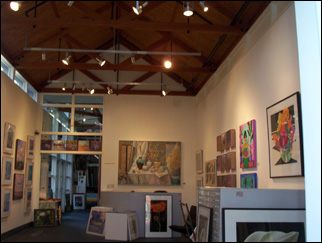
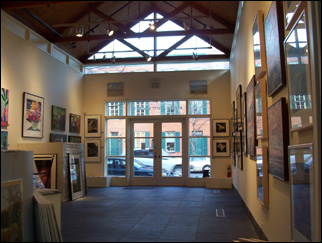
Scott received his B.A. in Liberal Arts from Loyola College in Baltimore
in 1983 and his M.A. in Art History with honors from the University of Maryland,
College Park in 1988. On the graduate level he specialized in 19th and 20th
century American art, studying with esteemed professors Dr. David C. Driskell, Dr. Elizabeth Johns and Jack Burnham, writing his M.A. thesis on nationally acclaimed Chicago
artist Hollis Sigler, whom he has represented since 1988.
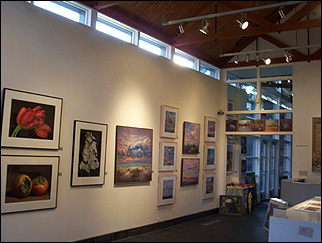 In 2002, Scott became a Member of the National Advisory Board of the National
Museum of Women in the Arts, Washington, DC. Selections from Scott's private collection of contemporary
American women artists have been on view at the Museum over the past twenty five years. "Steven Scott Collects," a major exhibition of Scott's gifts and promised gifts to the Museum was presented at the National Museum of Women in the Arts from June 10 to September 10, 2005.
In 2002, Scott became a Member of the National Advisory Board of the National
Museum of Women in the Arts, Washington, DC. Selections from Scott's private collection of contemporary
American women artists have been on view at the Museum over the past twenty five years. "Steven Scott Collects," a major exhibition of Scott's gifts and promised gifts to the Museum was presented at the National Museum of Women in the Arts from June 10 to September 10, 2005.
After fourteen and a half years on North Charles Street in
downtown Baltimore, Steven Scott Gallery relocated to the northwest
Baltimore suburb of Owings Mills, MD, in January 2003.
The gallery returned to downtown Baltimore to the waterfront
community of Fells Point in January 2009. The gallery's new location,
its most stunning space to date, features soaring 25 foot timbered
ceilings and numerous skylights. Originally built in 2000 as the
Conference and Visitor Center of the Preservation Society of Fells
Point, the new space will allow the gallery's artists to exhibit their
work in a spectacular, light filled venue along Baltimore's Historic
waterfront. We look forward to your visit!
FORMER LOCATION JANUARY 2009 - MARCH 2020
STEVEN SCOTT GALLERY
808 SOUTH ANN STREET
BALTIMORE, MARYLAND 21231
410-902-9300
FORMER LOCATION FROM APRIL 2020 T0 AUGUST 2023
STEVEN SCOTT GALLERY
917 STUBBLEFIELD LANE
BALTIMORE, MARYLAND 21202
NEW LOCATION AS OF AUGUST 20, 2023:
STEVEN SCOTT GALLERY
18 PEREGRINE COURT
PIKESVILLE, MARYLAND 21208
410-902-9300
PRIVATE DEALERSHIP AND FINE ART ADVISORY
BY APPOINTMENT ONLY
Contemporary Fine Art since 1988
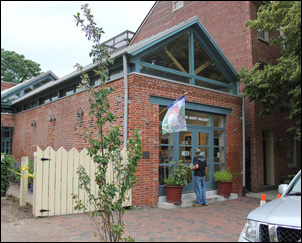
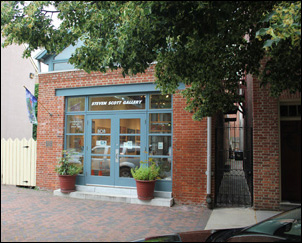
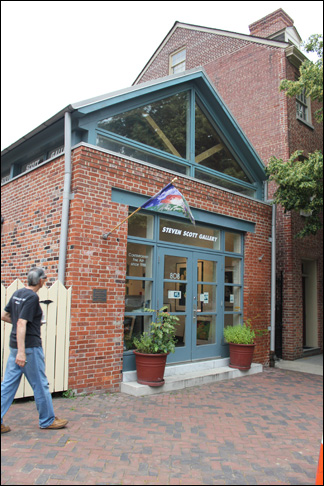




Steven Scott and nationally acclaimed sculptor and printmaker Alison Saar at the National Museum of Women in the Arts, Washington, DC, for her solo exhibition, "Alison Saar: In Print", summer 2016.
PHOTOS OF OUR FORMER OWINGS MILLS, MD, LOCATION BELOW








Gallery artist Carla Golembe and Steven Scott at the April 2003 opening reception for "The Female Factor: Fifteenth Anniversary Exhibition"
Life Lessons
From an actor to a dancer to an art museum director, 13 Baltimoreans share what they've learned from their long careers in the arts.
The Gallery Owner
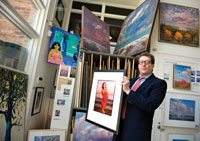 In 1988, Steven Scott took a chance and opened his own art gallery on Charles Street to showcase established American artists. Twenty-three years and two moves later, more than half of the gallery's 20 represented artists remain from that core group. At his newest location in Fells Point, he'll be highlighting the oils and monotypes of seven of his artists in this fall's show, "Painterly Brushwork," Oct. 4 through Dec. 31.
In 1988, Steven Scott took a chance and opened his own art gallery on Charles Street to showcase established American artists. Twenty-three years and two moves later, more than half of the gallery's 20 represented artists remain from that core group. At his newest location in Fells Point, he'll be highlighting the oils and monotypes of seven of his artists in this fall's show, "Painterly Brushwork," Oct. 4 through Dec. 31.
I first fell in love with art in the first grade on a field trip to the National Gallery. I saw the Renoir painting 'A Girl with a Watering Can.' I was drawn to the dazzling light, the inspired composition, the extraordinarily rich color and the intermittent flecks of sunlight infusing the surface of the canvas. The painting truly glowed.
I didn't always know that I wanted my own gallery. I originally thought I would be a museum curator. When I worked in the museums, I found local and regional artists that had great talent but no representation in Baltimore or D.C. After following their work for a few years, I found that I had a high-quality group of artists that were saleable and important. So I took a leap.
It's feast or famine. The winters are slow and the summers are busy. I can tell how well the gallery is doing by looking at the stack of art magazines on my desk. If there's a large stack and lots of e-mails, then I'm behind. If I'm caught up, we're having a slow period. It's always a roller coaster ride, but it all evens out in the end.
If you have a dedicated collector base and a quality group of artists you stick with, even new galleries can make it in Baltimore.
Many people are scared because conceptual art makes them feel stupid. You should always look, read and explore. Even with a graduate degree, I still don't understand Jackson Pollock. Or his allure, for that matter.
In '89, a collector walked into the Charles Street gallery with a big green trash bag over her shoulder. She threw it down in the middle of the floor and out came huge ornate, purple drapes. She needed a large purple painting to match the purple drapes! I tried to discourage her from buying to match— art should blend, but you should buy it because you love it.
The most important thing an artist can do is come up with a signature style—the kind where even if there is no sign, you can look at it and know who created it.
Many of my artists are set in their ways. I have to treat some with kid gloves. But the majority have been an absolute pleasure to work with. I support them and they support me. I know their quirks after 23 years. My artists stay true and paint for themselves, not the marketplace.
Some people just buy a piece to match their sofa or walls. Homes are not museums; there are restrictions with what you can display. Art needs to blend and enhance.
A large percentage of people that come to galleries don't know the difference between lithographs and screen prints. It's part of my job to educate— not everyone is an aficionado. When collectors understand the technique, they appreciate the pieces so much more.
If you really look at the works, it should take 10 visits to see the National Gallery. —As told to Laura Lefavor
Link to the Original Article.
Courtesy Baltimore Style Magazine, Sept/Oct 2011, p. 135

Renoir's "A Girl with a Watering Can", 1876, National Gallery of Art, Washington, DC. The very first painting which Steven Scott fell in love with on a school trip in first grade and which sparked his lifelong journey into the world of art.
"GIFTS FROM STEVEN SCOTT"
A recent article in the Summer 2022 issue of WOMEN IN THE ARTS magazine.
Published by the National Museum of Women in the Arts, Washington, DC,
on the occasion of Scott's donation of numerous works of art to the collection in 2022.
"STEVEN SCOTT COLLECTS"
NMWA article and interview with Steven Scott and Museum Director Dr. Susan Fisher Sterling
in the Summer 2005 issue of WOMEN IN THE ARTS magazine.
Published on the occasion of the major exhibition of gifts and promised gifts to the NMWA permanent collection in summer 2005.
GUERRILLA GIRLS: MAKING TROUBLE
A MAJOR EXHIBITION AT THE NATIONAL MUSEUM OF WOMEN IN THE ARTS, WASHINGTON, DC
Featuring important selections from the complete archive of printed lithographic broadsides and printed ephemera from 1985 to 2005,
donated by Steven Scott and now on view for the second time through September 28, 2025. Click here to read the informative article
on these groundbreaking feminist activists (including statements by Steven Scott) by NMWA curator Hannah Shambroom from the
Summer 2025 issue of WOMEN IN THE ARTS magazine published by NMWA.
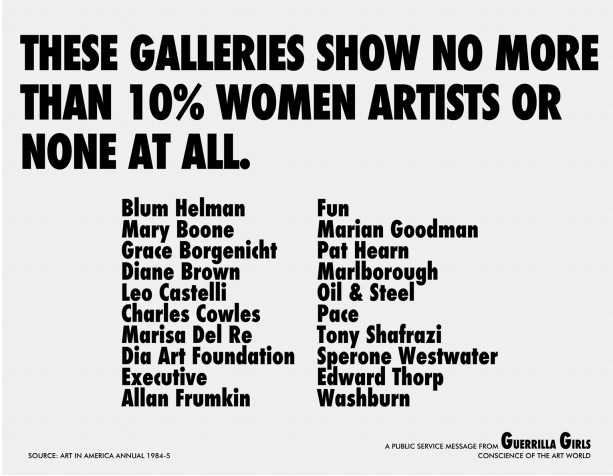
GUERRILLA GIRLS (founded 1985), THESE GALLERIES SHOW NO MORE THAN 10% WOMEN ARTISTS OR NONE AT ALL, from the series
GUERRILLA GIRLS TALK BACK: THE FIRST FIVE YEARS, 1985-1990
photolithograph on paper, 17 x 22"
NMWA, gift of Steven Scott, Baltimore, in honor of NMWA Founder Wilhelmina Cole Holladay.
© GUERRILLA GIRLS, courtesy of WWW.GUERRILLAGIRLS.COM.
Steven Scott Gallery
18 Peregrine Court
Pikesville, Maryland 21208
410-902-9300


|




 In 2002, Scott became a Member of the National Advisory Board of the National
Museum of Women in the Arts, Washington, DC. Selections from Scott's private collection of contemporary
American women artists have been on view at the Museum over the past twenty five years. "Steven Scott Collects," a major exhibition of Scott's gifts and promised gifts to the Museum was presented at the National Museum of Women in the Arts from June 10 to September 10, 2005.
In 2002, Scott became a Member of the National Advisory Board of the National
Museum of Women in the Arts, Washington, DC. Selections from Scott's private collection of contemporary
American women artists have been on view at the Museum over the past twenty five years. "Steven Scott Collects," a major exhibition of Scott's gifts and promised gifts to the Museum was presented at the National Museum of Women in the Arts from June 10 to September 10, 2005.















 In 1988, Steven Scott took a chance and opened his own art gallery on Charles Street to showcase established American artists. Twenty-three years and two moves later, more than half of the gallery's 20 represented artists remain from that core group. At his newest location in Fells Point, he'll be highlighting the oils and monotypes of seven of his artists in this fall's show, "Painterly Brushwork," Oct. 4 through Dec. 31.
In 1988, Steven Scott took a chance and opened his own art gallery on Charles Street to showcase established American artists. Twenty-three years and two moves later, more than half of the gallery's 20 represented artists remain from that core group. At his newest location in Fells Point, he'll be highlighting the oils and monotypes of seven of his artists in this fall's show, "Painterly Brushwork," Oct. 4 through Dec. 31.

